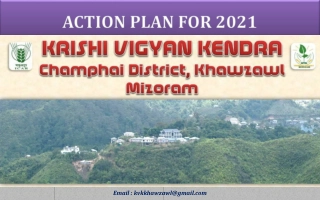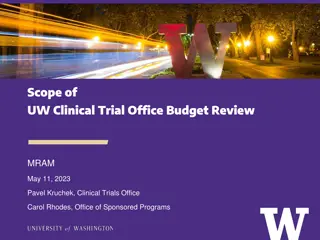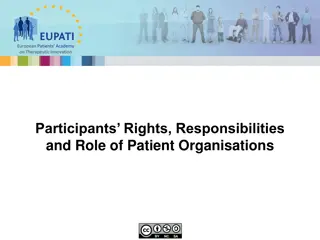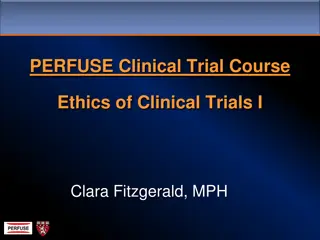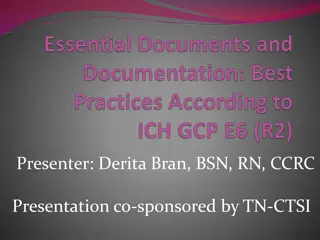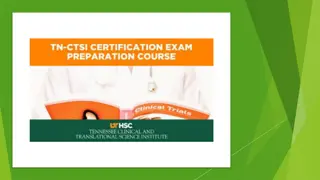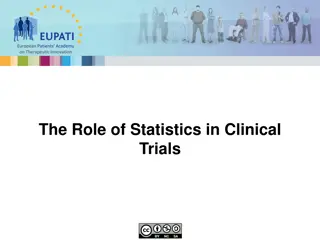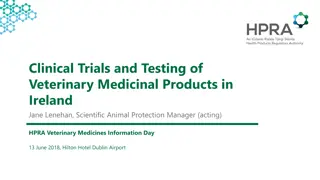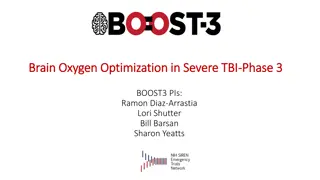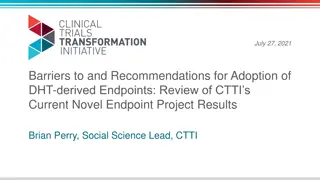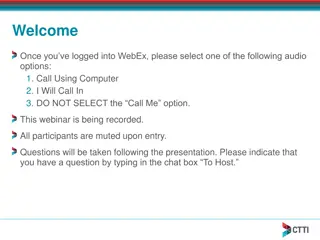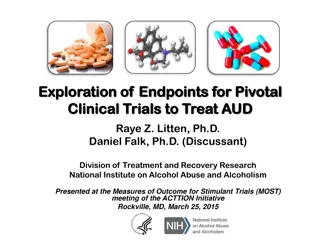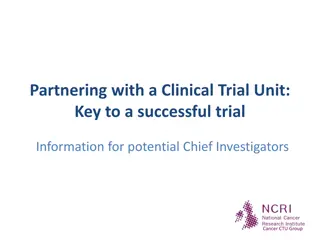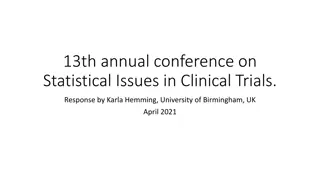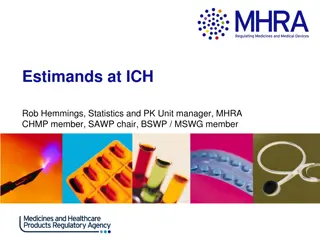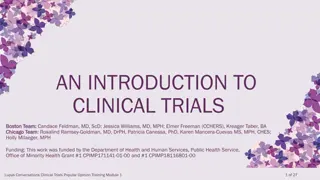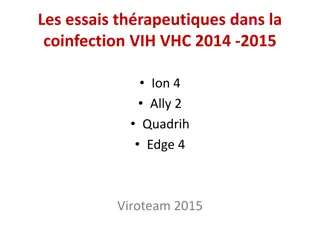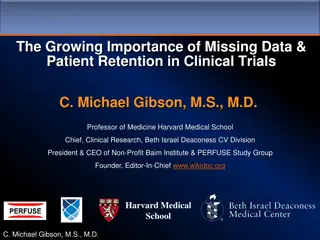Enhancing Patient Engagement in Clinical Trials
This presentation highlights the importance of patient engagement in clinical trials, showcasing the value it brings to the drug development process. It covers various aspects such as quantifying impact, identifying opportunities, and the role of patient groups. The Clinical Trials Transformation Initiative (CTTI) emphasizes involving patients as equal partners, integrating them into project teams, and advocating for stakeholder inclusion in the trial process. The involvement of various stakeholders, including patients, caregivers, regulatory agencies, and industry, is crucial for designing effective and streamlined clinical trials.
Download Presentation

Please find below an Image/Link to download the presentation.
The content on the website is provided AS IS for your information and personal use only. It may not be sold, licensed, or shared on other websites without obtaining consent from the author. Download presentation by click this link. If you encounter any issues during the download, it is possible that the publisher has removed the file from their server.
E N D
Presentation Transcript
Welcome Once you ve logged into WebEx, please select one of the following audio options: 1. Call Using Computer 2. I Will Call In 3. DO NOT SELECT the Call Me option. This webinar is being recorded. All participants are muted upon entry. Questions will be taken following the presentation. Please indicate that you have a question by typing in the chat box to the Host.
February 27, 2020 Embracing the Value of Patient Engagement Joseph DiMasi, Tufts Center for the Study of Drug Development Jaye Bea Smalley, formerly of Celgene
Disclaimer The views and opinions expressed in this presentation are those of the individual presenter and do not necessarily reflect the views of the Clinical Trials Transformation Initiative or Tufts University.
Brief Agenda Time Topic Introduction: Patient Groups & Clinical Trials Presenter 12:05 p.m. Zachary Hallinan Quantifying the Impact of Patient Engagement: A Modeling Approach 12:10 p.m. Joseph DiMasi Identifying High-Value Patient Engagement Opportunities 12:25 p.m. Jaye Bea Smalley 12:40 p.m. Discussion and Q&A Please indicate that you have a question by typing in the chat box To Host.
CTTI Strengths Public-Private Partnership Co-founded by Duke University & FDA Involves all stakeholders 80+ members MISSION: To develop and drive adoption of practices that will increase the quality and efficiency of clinical trials
Patient Engagement at CTTI Normed (no question) inclusion of patients as equal partners into every aspect of clinical trial (reform) Full integration into the Steering Committee Individual patients reimbursed for time on CTTI activities incl. projects Patient/caregivers on project teams have played critical role in shaping many projects Co-founded Patient Engagement Collaborative with FDA Almost all CTTI recommendations advocate for involving all stakeholders and particularly patients in the process, including our Quality by Design work which is included in ICH E8 renovation
Clinical Trials Stakeholders CDRH/CBER 2019 draft guidance: FDA believes medical device clinical investigations prospectively designed with input from patient advisors may help to address common challenges. Clinical Investigat ors Patients, Caregive rs & Patient Advocac y Groups Governm ent & Regulato ry Agencies ICH E8(R1) 2019 draft: Clinical study design is best informed by input from a broad range of stakeholders, including patients and treating physicians. Better Streamlined Fit for purpose Clinical Trials s Equal Partner Industry (pharma, bio, device, CRO, & tech) Academi a Trade & Professio nal Orgs IRBs
Donna Cryer*, President and CEO of the Global Liver Institute, delivered the keynote presentation challenging attendees to reflect on what she considers a broken system in which barriers to patient engagement are still numerous despite years of collective effort. https://www.ctti-clinicaltrials.org/enhancing-the-incorporation-of-patient- perspectives-in-clinical-trials/ *Member of CTTI Executive Committee
Providing PGs w/ only a token seat at the table Internal resistance, lack of buy-in Mismatched expectations between trial teams & PGs Perceived difficulty of overcoming legal barriers to collaboration Excluding PGs from early stages of trial planning & design Lack of engagement best practices & infrastructure Lack of demonstrated value Lack of sophistication of PGs MODIFIABLE BARRIERS TO COLLABORATION Unsure of how to identify/ engage w/ PGs Lack of funding
CTTI Resources Developed for Engaging Patient Groups in Clinical Trials Identifying Best Practices Describing Value & Impact Recommendations: Effective Engagement with Patient Groups Around Clinical Trials Economic model to quantify the financial value of patient engagement Implementation resources Online prioritization tool for identifying high-value engagement opportunities Patient Group Organizational Expertise and Assets Evaluation Assessment of Patient Group Internal Aspects Assessment of Patient Group External Relationships All resources freely available at https://www.ctti-clinicaltrials.org/our-work/patient-engagement/patients-groups-clinical-trials/
CTTI Resources Developed for Engaging Patient Groups in Clinical Trials Identifying Best Practices Describing Value & Impact Recommendations: Effective Engagement with Patient Groups Around Clinical Trials Economic model to quantify the financial value of patient engagement Implementation resources Online prioritization tool for identifying high-value engagement opportunities Patient Group Organizational Expertise and Assets Evaluation Assessment of Patient Group Internal Aspects Assessment of Patient Group External Relationships All resources freely available at https://www.ctti-clinicaltrials.org/our-work/patient-engagement/patients-groups-clinical-trials/
Patient Groups & Clinical Trials Project Team (2014 2019) Linda Brennan (CFF)* Richard Klein (FDA)* David Leventhal (Pfizer)* Jaye Bea Smalley (Celgene)* Sophia Smith (Duke)* Amy Abernathy (Duke) Ronald Bartek (FARA) Joel Beetsch (Celgene) Patricia Cornet (BMS) Joe DiMasi (Tufts) Eric Eisenstein (Duke) Ken Getz (Tufts) Michele Goldberg (J&J) Matthew Harker (Duke) Sharon Hesterlee (Bamboo Therapeutics) Bennett Levitan (J&J) Jim Kremidas (ACRP) Paulo Moreira (EMD Serono) Bray Patrick-Lake (Duke) Steve Roberds (Tuberous Sclerosis Alliance) Jamie Roberts (Duke) Al Roy (Lupus Research Alliance) Wendy Selig (WSCollaborative) Jeff Sherman (DIA) James Valentine (Hyman, Phelps & McNamara) Scott Weir (University of Kansas) CTTI: Zachary Hallinan (PM) Amy Corneli (Social Science) Rae Holliday (Comms) Laura Shannon (Comms) *Project team leader | Affiliations indicated as primary at time of project participation
Quantifying the Impact of Patient Engagement: A Modeling Approach
Prospective Modeling Overview Apply a commonly used and widely accepted method for modeling financial value based on project development cost, time and risk Base cases: Typical phase II and III oncology development programs What-if scenarios to test model: Assumed avoidance of one protocol amendment Assumed 3 month faster enrollment (due to more feasible and convenient participation) All data used to populate model based on published benchmark and source data Assessing the Financial Value of Patient Engagement: A Quantitative Approach from CTTI s Patient Groups and Clinical Trials Project. Therapeutic Innovation and Regulatory Science 2018;52(2):220-229
Development Program Value Drivers Revenue Cost Time Financial benefits accruing from project success Out-of-pocket & opportunity cost When costs, revenue, & risks occur *Note: Strategic and intangible values not included
Risk Factors Impacting Value Scientific & technical risks driving whether to advance development Efficacy, safety, competitors, comparative effectiveness and economics Regulatory risk driving approval and launch Operational risk driving timely, efficient and compliant development activity Resource risk driving the accuracy of capacity and resource allocation Forecasting risk driving accuracy of predicted development performance and investment Patient quality of life, satisfaction, receptivity influencing development decisions
Modeling Value and Impact Circles represent studies or other key milestones/risks Probabilities assigned based on scientific, operating & regulatory risk Each development path has an associated cost or reward expressed as cash flow in net present value terms Treatment launched Succeed Succeed Regulatory Approval Fail Succeed Phase 3 Failures Resulting in Termination Fail Phase 2 Fail
Adjusting Value for All Expected Risk Outcomes Prob NPV ($millions) NPV for technical & regulatory success Succeed 22% 400 90% Succeed Regulatory Approval 60% Fail NPV for regulatory failure Succeed 2% -45 Phase 3 10% 40% Fail Phase 2 16% -40 40% NPV s for technical failures Fail 60% -3 60% eNPV = Expected Net Present Value = NPV adjusted for risk = 0.22 x 400 0.02 x 45 0.16 x 40 0.60 x 3 = $77 MM
Patient Engagement Assumptions $50,000 - $100,000 patient engagement initiative investment required Improved Protocol Feasibility Resulting in One Amendment Avoided Phase 2 and 3 amendments cost $141,000 and $535,000 to implement respectively 70% of protocols have at least one amendment; 22% of amendments are due to recruitment difficulty or site execution difficulty A single amendment adds 3 months of time to implement Improved Protocol Feasibility Resulting in More Convenient Participation ICF easier to understand Eligibility criteria simplified Participation burden for patients reduced Arbitrary 3 months of study cycle time saved
Modeling Results Avoid One Amendment Improve Convenience Phase II Phase III Phase II Phase III eNPV Impact on $100,000 Invested +$3.8 million +$15.0 million +$30.1 million +$57.0 million For engagement activities resulting in avoiding an amendment and/or an improved patient trial experience, the benefits in eNPV vastly outweigh the resources spent on engagement.
Expansion of an eNPV Value Framework for Evaluating Patient Engagement Methods
Overview Primary AIM to expand on initial eNPV modeling & establish a resource for researchers and companies to assist them in constructing models for a wide variety of scenarios Expanded list of variables and inputs Useful references for gathering benchmark & case study data to populate eNPV models & guide model assumptions Authored by Joseph DiMasi (Tufts) & Kenneth Getz (Tufts) in collaboration with Bennett Levitan (Janssen)
Drivers and Parameters Value drivers: Cycle time Direct cost Success rates Commercialization Parameters: Drug development cost, cycle time, risk Regulatory approval times Sales & market expense Effective patent life Effective corporate tax rate & cost of capital Public & patient attitudes & experience in clinical trials Patient centric approaches cost & impact Expanded benchmarks for additional therapeutic areas
Resources Economic Model Development & Market 14 primary sources cited Public and patient attitudes & experience in clinical trials 28 primary sources cited Patient centric approaches cost & impact 70 case examples referenced
Conclusions Pilot study published & well-received Resources identified that can be used to expand the analytical framework to other disease categories & additional patient engagement methods Could be expanded by researchers, internally as a tool by sponsors, or as a collaborative online tool
Identifying High-Value Patient Engagement Opportunities
Patient Group Engagement Across the Clinical Trial Continuum* Patient groups have potential to enhance the quality & efficiency of clinical trials by providing: Financial support for research Natural history data Input on relevance of research to patients Access to translational tools Help defining eligibility criteria Input on meaningful endpoints & PROs Advocacy for policy & funding issues Education to patient community Support to sponsors around key regulatory meetings Support preparing submissions for newborn screening for rare diseases Informing regulators on benefit-risk Public testimony at regulatory meetings Discovery & Pre-Clinical Phase 1 - 3 Post- Approval Regulatory Review Benefit-risk & patient-preference studies Protocol design & study feasibility input Study recruitment & retention strategy input Increased awareness about trials Participant feedback on trial experience Input on informed consent content & processes Peer advocates for participants Clinical trial networks Data Safety Monitoring Board members Phase 1-3 activities and Support interpreting & disseminating study results Collaboration on post-marketing studies & surveillance initiatives Support developing access strategy & preparing for value or health technology review *Updated 2018; adapted from Parkinson s Foundation materials | Patient group activities typically undertaken independently or with partners other than sponsors | Includes early planning for trials
How Sponsors & Patient Groups Define Value When evaluating potential INVESTMENTS and RISKS: When evaluating potential BENEFITS consider: Scope of impact of the activity on your patient population/org/co Amount of financial resources needed Level of staff time & expertise required across the lifespan of the activity Necessity of patient group involvement to conduct the activity Necessity of the activity to advance medical product development Amount of additional organizational commitment needed given existing infrastructure Amount of direct patient involvement & potential patient burden Ease of accomplishing the activity in the short-term Reputational benefits Reputational risks Based on semi-structured interviews conducted with representatives of sponsors (n=14) and patient groups (n=14) to understand how each characterizes investments and benefits of engagement
How Sponsors and Patient Groups Define Value When evaluating potential INVESTMENTS and RISKS: When evaluating potential BENEFITS consider: Scope of impact of the activity on your patient population/org/co Amount of financial resources needed Level of staff time & expertise required across the lifespan of the activity Necessity of patient group involvement to conduct the activity Necessity of the activity to advance medical product development Amount of additional organizational commitment needed given existing infrastructure Amount of direct patient involvement & potential patient burden Ease of accomplishing the activity in the short-term Reputational benefits Reputational risks Based on semi-structured interviews conducted with representatives of sponsors (n=14) and patient groups (n=14) to understand how each characterizes investments and benefits of engagement
Web-Based Tool for Identifying High-Value Engagement Opportunities Provides a simple, straightforward process for sponsors & patient groups to identify opportunities to work together INVESTMENT Step 1: Identify engagement opportunities High Low Step 2: Evaluate investments & benefits High High Benefit High Investment High Benefit Low Investment BEST BENEFIT Step 3: Visualize & discuss mutually beneficial activities Low Benefit High Investment Low Benefit Low Investment Low WORST Tool is freely available at https://prioritizationtool.ctti-clinicaltrials.org/
Finding the Best Approach Economic Impact Qualitative Evaluation
Recommendations for Sponsors Establish ongoing relationships with patient groups & communicate openly with them on a regular basis. 1) Ensure that patient groups are essential partners throughout the research & development process and not token voices. 2) 3) For consistency, establish guiding principles & clear lines of communication to facilitate a fit-for-purpose process for collaborating with patient groups. Integrate into your ongoing research & portfolio planning an assessment of patient group expertise & assets and value to your program. 4) Match patient group expertise & assets to the specific needs & phases of your research & development programs. 5) Measure the impact of patient group engagement on cycle time & other metrics. 6)
Recommendations for Patient Groups 1) Proactively identify, engage, & bring the patient voice to stakeholders relevant to your research & development interests. Promote your value as an essential partner by maximizing & articulating your expertise & assets. 2) Deliver your expertise & assets to research sponsors throughout the entire research & development lifecycle. 3) Patient groups should select sponsors who have a product or development program with significant promise for their constituents & who are committed to engaging in a meaningful way. 4) Manage real or perceived conflicts of interest by establishing policies that require full disclosure, transparency, & accountability. 5)
CTTI Patient Engagement Resources Economic Model: https://www.ctti-clinicaltrials.org/sites/www.ctti- clinicaltrials.org/files/new_ctti_resource_26feb2020_final.pdf Prioritization Web Tool: https://prioritizationtool.ctti-clinicaltrials.org/ Recommendations: Realizing the Value of Effective Patient Group Engagement https://www.ctti-clinicaltrials.org/our-work/patient-engagement/patients- groups-clinical-trials/ Quality by Design (QbD) Mobile Clinical Trials Patient Engagement Collaborative Patient Engagement Collaborative Quality by Design (QbD) Mobile Clinical Trials Additional Resources for Engaging Patients in Clinical Trials
THANK YOU. Webinar recording & slides available at: https://www.ctti-clinicaltrials.org/webinars/ www.ctti-clinicaltrials.org


